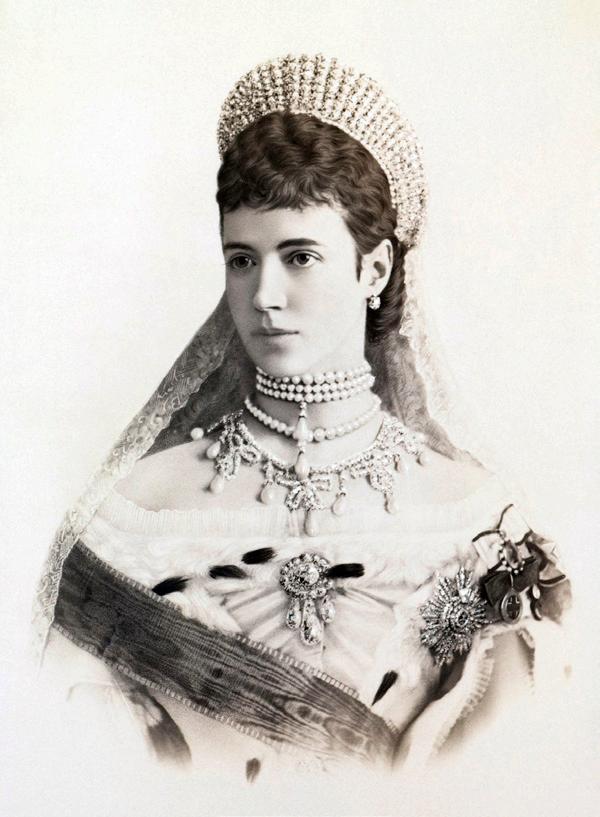
7 minute read
Lady of Tears
by Annette Lind
In 2006 the remains of a Danish princess were moved from Roskilde Cathedral in Denmark to be laid to rest in the St. Peter and Paul Church in Russia. This Danish princess arrived again in Russia on September 26, 2006, 140 years after the date she arrived in Russia from Denmark to marry Tsarivich Alexander who would one day become the Czar of Russia. This young princess would become the Empress of Russia and the mother of the last Russian Czar, Nicholas II. Her’s was an amazing and tragic life, earning her the sad title of “Lady of Tears.” Her name was Dagmar, but for most of her life she was Maria Feodorovna. Perhaps you already know her story—if not, it’s a story worth knowing. Princess Dagmar was born in 1847. She was the fourth child born to Prince Christian and Princess Louise of Denmark. Her full name was Marie Sofia Frederikke Dagmar of SchleswigHolstein Sonderburg-Glucksborg. She was known to the Danish people as Dagmar (Bringer of Light). When she was born there was little chance of her father becoming a king. But if you remember from a previous article on King Frederik IX (father of Dronning Margrethe II) because King Frederick VII had no children and basically the Oldenburg lineage had no one in line to be his heir, The Acts of Succession of 1853 named Prince Christian to be the heir to the Danish throne. With the death of King Frederik VII Dagmar’s parents became King Christian IX and Queen Louise of Denmark. Despite being born to parents who would one day rule Denmark, her life was surprisingly modest. She lived in the Yellow Mansion (this building can still be seen in Copenhagen next to Amalienborg Palace. Originally it was built for a Danish merchant, but King Frederik VII purchased it in 1810 to use as a guest residence. In 1837 he gave it to Prince Christian though at that time there was no thought that Christian would one day become King of Denmark. Dagmar’s family was relatively poor for royalty. The children were educated by their parents, and the three girls in the family sewed their own clothes. Dagmar was one of six children: Frederik, Alexandra, William, Dagmar, Thyra and Waldemar. Shortly after their father Christian IX ascended to the throne, Alexandra married Edward, the Prince of Wales, son of Queen Victoria. She would eventually become Queen of England. Later that same year William was named King of Greece and became known as King George. Dagmar was considered by Queen Victoria as a bride for her son Alfred. Dagmar was also considered as a wife by Prince Umberto of Italy who would become King Umberto I. It was, however, another suitor that eventually caught her eye, Tsarivich Nicholas of Russia. He had first seen Dagmar in a picture of the princess when she was 12 years of age. It is said Nicholas was fascinated with her. In 1864 he visited Denmark to meet Dagmar. They became engaged. It seems the two fell very much in love, but they were never to be married. Nicholas became ill with meningitis in Nice, France. Dagmar and her mother rushed to his side. He died on April 24, 1865. There is a story that on his death bed Nicholas asked his brother, Alexander, to marry Dagmar and make her happy. It is hard to know if the story is true. Alexander was already in love with one of this mother’s maids of honor. However, his father, Czar Alexander II, ordered his son to go to Copenhagen and Dagmar again became engaged to a son of the
Advertisement
Russian Czar. They were married in Russia on November 9, 1866. Dagmar was 19 years old. Her parents, King Christian IX and Queen Louise could not afford to attend the wedding and instead sent their oldest son Frederik who would one day become Frederik VIII, King of Denmark. Christian IX became known as the “Father-in-law of Europe” with three of his children becoming Kings or Queens of other European countries and his oldest son the King of Denmark. Dagmar converted to the Russian Orthodox Church and became Grand Duchess Maria Feodorovna. (Although her name was changed, throughout most of this article she will be referred to as Dagmar, the name she continued to be known by in Denmark.) The two were quite different from each other. Alexander was a large man and while he could be good-natured, he could also be quite gruff. He was not interested in social life. His family called him Sasha. Dagmar, on the other hand was a petite woman who loved dancing and parties. Her family called her Minny. Despite the differences, as the years passed they both let go of their first loves and had quite a happy marriage. One source even commented that Alexander was the first Romanov to be faithful to his wife in over 200 years.
Their first child was born in 1868 and was named Nicholas after Dagmar’s first love, Alexander’s brother. Next came another son, Alexander, who died before his first birthday. Following came George, Xenia, Michael and Olga. In 1876 the Serbians declared war on Turkey. Russia eventually entered the war on the side of Serbia. Dagmar trained as a nurse in St. Petersburg Hospital and eventually worked in military hospitals helping the wounded. As President of the Red Cross in Russia her work for the war eventually became one of an administrator sorting out the chaos that had erupted in the hospitals and volunteer relief organizations as a result of the war. The poor negotiations for division of property following the war led directly to World War I. Russia lost much of the territory they had conquered in the war. The Czar lost the favor of his people and a revolutionary feeling arose among the Russians. Hatred of the Czar increased. Czar Alexander II, Dagmar’s father-inlaw, is perhaps best known to Americans because in 1867 he sold Alaska to us for $72 million dollars. Shortly after this war Alexander II’s wife, Empress Maria, died. Alexander II became involved with his mistress Catherine Dolgorukov. Dagmar disliked Catherine and the relations between the Czar and his son and daughter-in-law grew very strained. However, before he could make Catherine his Empress, fate stepped in. Between the years of 1866 and 1880 there were 8 attempts made to assassinate the Czar, despite his instituting many reforms in Russia. While traveling home to the Winter Palace after reviewing the troops. a bomb was thrown at his carriage. The Czar survived this first attack, but when he stepped out of the carriage another bomb was thrown at him. He was mortally wounded while his son and grandson watched. He died shortly after being taken to the Winter Palace on March 13, 1881. This assassination greatly affected Dagmar who afterward lived in fear for her husband. It also greatly affected Russia because both Alexander III who became the new Czar and his son Nicholas II reacted by removing the reforms. Russia became a country with major suppression of liberties and police brutality Coryne Hall in her book Little Mother of Russia writes, “Terrorists were hunted down and imprisoned, newspapers, books and magazines were heavily censored, university studies were curtailed and student organizations suppressed. Civil liberties were suppressed at will. Those who did not share the Czar’s beliefs in autocracy began the long trek to Siberia.” Secret police, forerunner of the KGB and known as Okhrana,

closely watched the Russian people. With the death of Alexander, Dagmar became Empress of Russia in 1883. She was 36 years old. The Danish Princess was well-loved by the Russian people. She quickly learned Russian and made a considerable effort to understand Be sure to check out the March 2021 issue of the DSN to finish reading about the Lady of Tears.
In Memoriam
NAME Cert # Lodge # Location Birth Date Birth Place Initiated Died Benefit Ebba Kadish 1249 12 New Haven, CT 1.1.25 Tarrytown, NY 12.16.03 09.01.20 0
Travel to Denmark from the Comfort of your Home!
Virtual Tours of Denmark via Zoom Continue
From now until March 16, 2021, the National Foundation for Danish America and The Danish Pioneer continue their free weekly series ‘Virtual Photo Tours of Denmark’ presented by Danish tour guide, Benedikte Ehlers Olesen. Each Tuesday at 11 am CST, Benedikte shows viewers a slice of our beloved Denmark.
March sessions will show ‘travellers’: March 2 - Skanderborg, Ry, Himmelbjerget, Viborg, Hjarbæk, Skive, Kokkedal March 9 - Jellinge, Vejle, Kolding, Lillebælt, Bogense March 16 - Odense, Tåsinge, Egeskov, Nyborg, Korsør, Roskilde
To register the for March sessions or to view past presentations, see the National Foundation for Danish America website: https://danishamerica.org/.
February & March Specials
Purchase a heart compact, heart flag earrings or a coral heart pendant and the profits from your purchase will go toward the DSS Archival Project.
danishsisterhood.org



